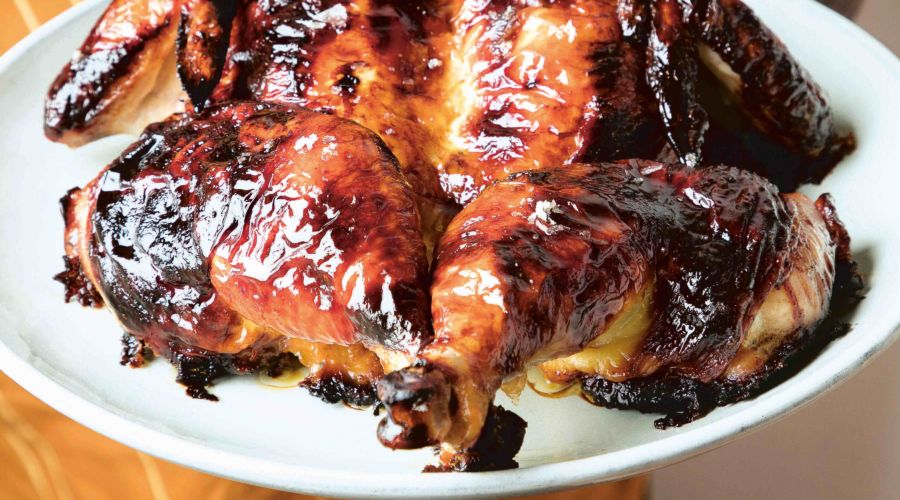Huli Huli Chicken

Chef Simeon explains that “‘Huli’ means ‘turn’ in Hawaiian, a reference to the special rotating grills used to cook this local style of rotisserie chicken. Huli huli, so the legend goes, was created by an enterprising poultry farmer named Ernest Morgado in 1955. In the decades since, it has become a favorite here, often sold at school fundraisers and stands that set up along the highway.
Recipes for huli huli tend to use teriyaki with the addition of ketchup or pineapple for tanginess. When I put huli huli chicken on the menu at Lineage, the idea was to combine those homey roadside flavors with how classic roast chicken is often presented at fancy restaurants. I start by coating the chicken in shio koji, a paste for marinating or seasoning made from fermented rice malt and salt, which has the dual effect of tenderizing the bird and unlocking a whole universe of savoriness. (Ready-to-use shio koji paste or marinade is available at most Japanese and Asian markets, or can be ordered online.)
Note: The easiest way to spatchcock a chicken is to have your butcher do it. Otherwise, use a sharp pair of kitchen shears to cut along both sides of the chicken’s backbone (spine), separating it from the ribs. With the backbone removed, turn the bird over so the breast is facing up. Splay out the legs and breast until they lie flat, and give the bird a firm press in the center of the breast; you may hear a crack, and it should lie flat on its own.
How to Make It
Place the chicken on a large sheet pan and rub all over with the shio koji. Cover loosely with parchment paper and refrigerate overnight.
In a saucepan, combine the chicken stock, butter, oyster sauce, pineapple juice, brown sugar, ginger, garlic, and sesame oil. Crush the white parts of the scallions with the butt of a knife and add those, too. Bring this to a boil, then reduce the heat and simmer for 30 minutes, stirring occasionally, or until the liquid has reduced by about half. Remove the ginger, scallions, and garlic using a slotted spoon or sieve.
In a small bowl, mix the cornstarch with 2 tbsp. water to make a slurry. Stir it into the sauce and increase the heat to bring back to a boil before removing from the heat.
An hour before you’re ready to cook, remove the chicken from the fridge and let it come to room temperature.
When you’re ready to cook the chicken, rinse off the shio koji and pat the chicken dry with a paper towel. Season the chicken lightly and evenly with garlic salt.
Preheat a grill to medium-hot. Using tongs, oil the grates of the grill with an oiled rag or paper towels. Set up the grill for two-zone cooking: If using coals, push them off to one side of the grill so you have direct and indirect heat. If using gas, reduce the heat to low on one side of the grill.
Place the chicken, breast-side up, on the cooler side of the grill. Cover and grill for 10 minutes. Uncover, brush the chicken with sauce, cover, and grill another 10 minutes. Uncover, glaze the chicken again, then flip the chicken breast-side down onto the hotter part of the grill. Cook over direct heat, uncovered, until the skin begins to brown and char slightly, about 10 minutes, then brush with sauce and flip the chicken breast-side up, still over direct heat. Brush the breast pieces with sauce and continue cooking the chicken over direct heat until the juices run clear or a thermometer inserted into the breast reads 160°F (plan for about 40 minutes total cook time). Remove the chicken from the grill and let rest for 15 minutes.
Meanwhile, bring any remaining sauce to a boil (if the sauce is broken, don’t worry, it will emulsify when it boils). Remove from the heat and let cool slightly. Slice the chicken and serve topped with some more sauce and the chopped scallion greens.

